EDIT: I no longer use the word "tarpan" as a synonym for the western wild horse. Tarpan was a term for horses of the southern Russian steppe that according to most recent research were hybrids of feral horses and the original wild horses.
In this post, we looked at the phenotypic and behavioural traits of the Tarpan, Equus ferus ferus, the western wild
horse subspecies. Today I’m going to introduce a number of horse breeds which apparently
share some characteristics with the Tarpan. But before we go into this, it’s
important to know where the wild horse was domesticated and how it left its
traces in the modern equine stock.
Equus ferus ferus seemingly is the wild type of the modern
domestic horse and there are no hints yet that the Przewalski horse played a
significant role in horse domestication. The Tarpan was domesticated in the
western Eurasian steppe approximately 6000 years ago, as it is indicated by
genetic [1] and archaeological [2] evidence. Interestingly, the modern domestic
horse has a considerably diverse mitochondrial DNA while the Y chromosome
diversity is very low, what suggests that only few wild stallions but a larger number
of wild mares was used in domestication [3, 4, 5]. Studies like Jansen et al.
and others suggest that there was local wild mare introgression within Europe. Ancient
breeders probably included wild mares into their stock to continue breeding on
a larger scale, but avoided working with wild stallions because of their
intractable behaviour [3, 4, 5].
What does
this genetic data tell us? Apparently most if not all horse breeds originated
in the Eurasian steppe, but local female influence was seemingly common as
well. The very low Y diversity of modern horses reveals another important
implication: if any horse breed is a direct descendant of a European wild horse
population, we would expect a significantly higher Y chromosome diversity in these
breeds, with haplogroups completely unknown in other horses. However, most
studies on horse genetics are concerned with mDNA, and Lindgren 2004 used a set
of 15 horse breeds that might not be representative enough. 6 of the included
European breeds belong to the northern pony type which possibly all are related
and not “divergent” as the study says (Exmoor Pony among them), and robust
horse breeds from eastern Europe such as the Konik or Hucule are missing. So I
think the hypothesis that no horse breeds are the result of comparably recent
and significant wild horse introgression requires more testing (although we can
tentatively rule it out for the breeds tested in Lindgren 2004).
Considering
that the Tarpan is the ancestor of all domestic horses, when we see traits in
horses that resemble what we know about the Tarpan (be it behaviourial or phenotypic)
we can carefully assume that these features are inherited by wild Tarpans. I
want to cover wild behaviour in horses in a following, separate post, so we’ll
focus on the phenotype, ecologic adaptions and breeding history of the
primitive horse breeds here.
Since the
Tarpan displayed a number of colour morphs, the horses that we can consider
primitive/less-derived/Tarpan-like (however you want to call it) don’t have to
look very much alike, there is actually a diverse set of good “candidates”.
Let’s start from west to east.
On Great
Britain you can find a lot of robust pony breeds with primitive colour and body
features, of which the most unchanged one is the Exmoor Pony. They seemingly
all descend from a feral pony type that once ranged on the entire island [6].
The primitive British Pony/Exmoor Pony
is a comparably small-bodied (130 cm at the shoulders), stocky horse with a
robust skull and is of a bay/seal brown coat colour with a light mealy mouth
and a light underbelly. These horses have a dark eel stripe, but it is (like in
most non-dun horses) not easy to recognize. The Exmoor Pony and its relatives
are known to be very robust and hardy. They perfectly cope with the harsh
british winters, while more derived breeds from the mainland do not nearly as
good [6]. Some primitive British ponies have a black colour, like the Fell Pony
(descending from the extinct Galloway Pony).
 |
| Exmoor Ponies |
 |
| Fell Pony |
Quite possibly, British ponies
also influenced other small northern horses, like the Gotland or the Fjord horse
(the latter is bay dun-coloured, by the way) [5].
 |
| Fjord horses |
| Gotland |
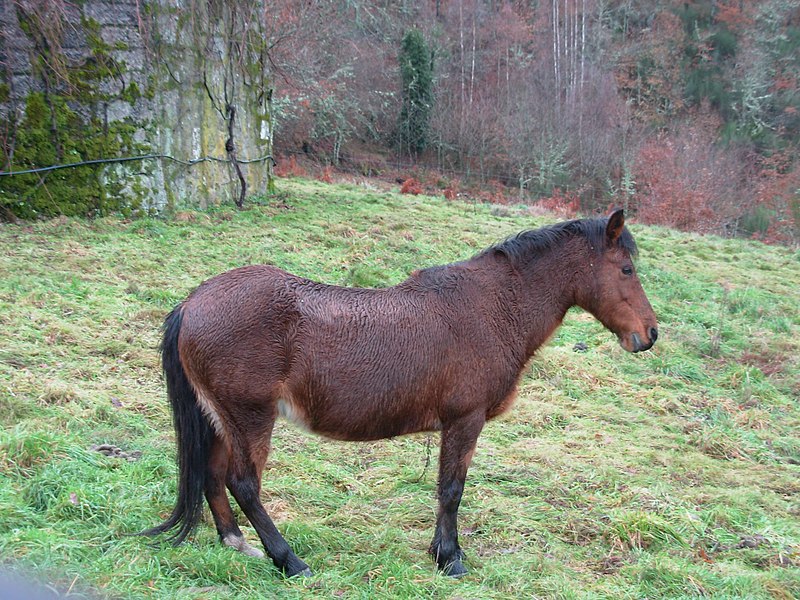 |
| Garrano |
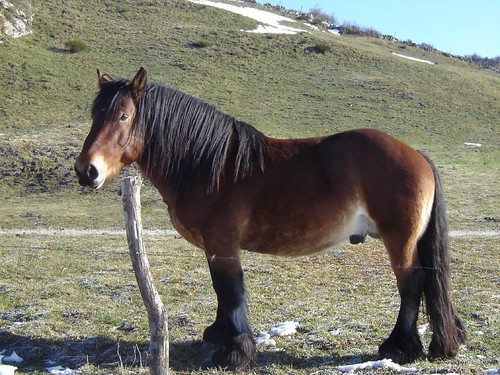 |
| Primitive Asturcons, there are black ones as well |
Some
Iberian ponies, like the Garrano,
Pottoka, Asturcon and others, resemble the Exmoor pony-type horses closely.
In some of these, like the Pottoka, this resemblance might be caused by British
introgression during the 20th century [7], but others like the
Asturcon have a longer history. Those primitive Iberian Ponies either are bay
or black, and some of them (f.e. Garrano), have feral populations.
Except for
the lack of the dun colour, this western pony type resembles the descriptions
of wild horses quite good (stocky and small body, large robust head, small
eyes, short mane, wild colour present etc.). However, as I discussed in the
previous post, the presence of wild horses lacking the dun factor cannot be
ruled out yet.
The area of
the former Austrian monarchy also has a set of primitive and hardy breeds with
a diverse ancestry. The Noriker horse
is a large (but there also was a smaller version of that breed called the
Abtenauer) and robust working horse from Austria that was influenced by Italian
and Spanish horses in the past. It shows (besides a number of domestic colours)
bay, black and leopard spotted individuals. They have a robust head with small
eyes and are tolerant against cold temperatures.
 |
| Noriker horses with wild horse colours and other primitive features |
The robust Hucul horse, from the eastern
Carpathians, is a breed that likely descends from horses coming from the
steppe. It’s size range is within that of the wild horse, and it displays a
number of colours including bay dun, black dun, bay and black. The dun individuals
have often have a prominent eel stripe and leg and shoulder striping. It is
more gracile than the primitive western ponies.
The Konik is similar to the Hucule, but
certainly has the most romantic story regarding its origin. Allegedly it
descends from wild horses that were donated to polish farmers who tamed and
crossbred them, and after that, a breeding-back project allegedly purged out
the domestic influence, resulting in the modern Konik. The reality behind this
story is a lot less romantic, but we will look into this in a future post. The
Konik is a robust polish pony which’s colour is predominantly black dun. It’s
phenotype varies from a more gracile riding horse type with a gracile head and
a long mane that does not truly resemble the wild horse in proportions, and a
robust type with wild horse-like proportions and skulls. It also has different
expressions of black dun, ranging from a very light gray (not likely for wild
horses), to a grayish brown resembling a mouse’s coat (very likely for wild horses).
In Germany,
there are two popular derivations of the Konik. One is the Heck horse which is
the result a breeding-back attempt by the Heck brothers and has influence of
other ponies like the Gotland and Icelandic horse, but also the Przewalski horse.
It is not necessarily more Tarpan-like than usual Koniks. The Dülmen Pony has a
long history but the modern population is a mix of Exmoor, Shetland and Konik
(with the Konik having the largest influence in this breed) and displays a
diverse phenotype.
 |
| Koniks with very wild horse-like coat colours (Photo: Volker Kirchberg) |
Moving more
eastwards, there is the Yakutian horse
of the Sakha Republic, Russia. It is comparably large (150 cm), but has a primitive
stocky body and is well-adapted to extreme coldness. Its coat colours (in pure
examples of the breed) can be bay or various dun colours, with or without
pangare. Selective breeding could breed out a Yakutian lineage showing wild
horse colour traits exclusively.
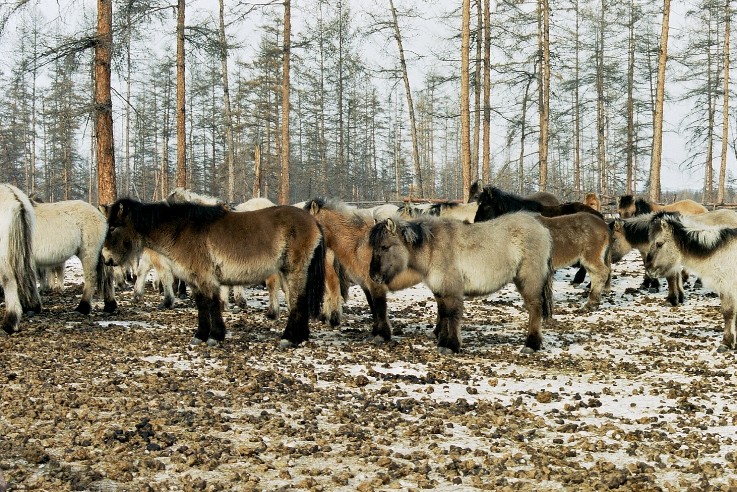 |
| Yakutian horses |
Another
primitive Asiatic horse is the Mongolian
horse. It is a robust and stocky breed, reaching 130 to 145 cm in height. Among
a number of domestic colours, it contains many of wild horse coat colours, such
as bay, bay dun, black and leopard spotted (I’m not sure if there are black dun
Mongolian horses). Of the Asiatic horse breeds, it has the greatest genetic
diversity [8], indicating that it might be an ancient lineage. And their
location isn’t far away from the domestication centre of all horses.
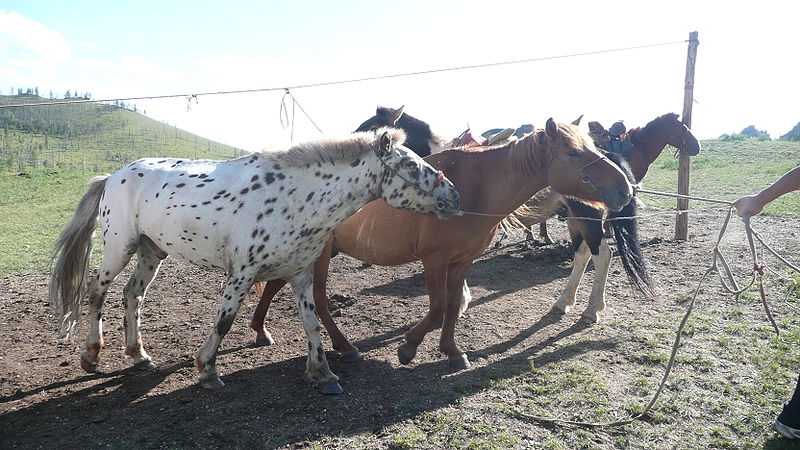 |
| Monoglian horses |
Surprisingly,
there are primitive horse breeds even outside the old world. Mustangs have a
diverse and controversial ancestry, some of them display a rather wild
horse-like phenotype (despite their comparably gracile build) and they have
experience in surviving in nature over generations. One of the most interesting
Mustang lineages is the Pryor Montain
Mustang, a population that is known living feral for at least 200 years and
descended mainly from the Spanish Barb and other lightly built horses. They
range from 130 to 150 cm in height and some of them show a bay, bay dun, black
or black dun colouring, including the wild markings. Some Sulphur Mustangs also show wild horse colour traits and a primitive
body conformation. Surely even ancient-looking Mustangs have more gracile
proportions than the primitive western pony breeds, but this may be due to adaption
living in a more open habitat. However, the hypothesis that Tarpans with that
proportions existed should be proven by osteometric data, since even the
Przewalski horse (native to a steppe habitat) has a stockier build than
mustangs do.
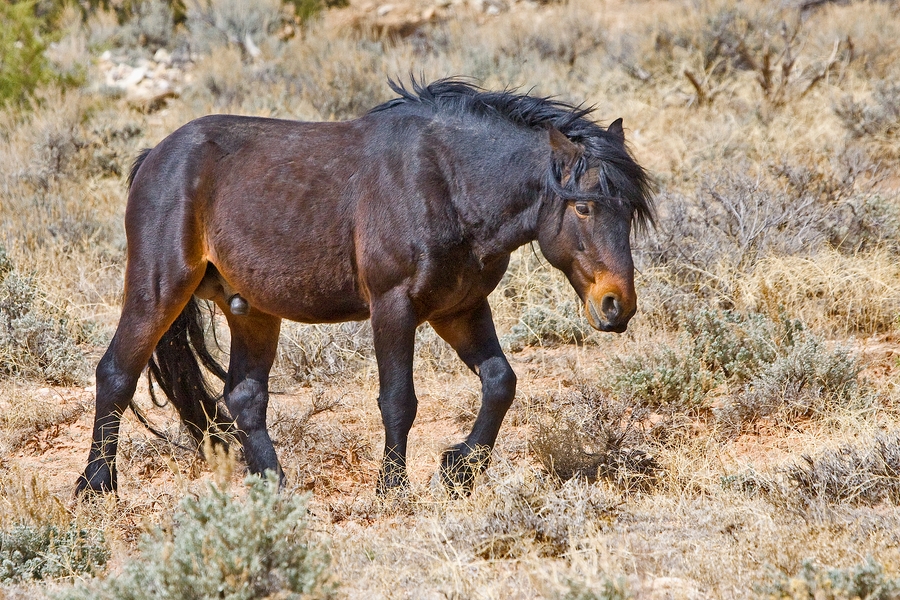 |
| Pryor Mountain Mustangs with Tarpan-like coat colours |
The Sorraia is a breed from the south of Iberia, and fanciers claim it is a surviving descendant of the Tarpan because of its black dun coat and the fact that the breed as such was not known before the 20th century. However, it is likely that the breed has an Arabic ancestry because of its tall and gracile build and the strongly convex head[7]. Some Mustang lineages, like Sulphur and Kiger, apparently share a common ancestor with the Sorraia, as there is a large resemblance between individuals of these breeds. Older genetic studies noted similarities of the Sorraia with the Konik or Przewalski horse, while more recent studies refuted this [5, 10]. Furthermore, the Sorraia is related to the Lusitano [9]. All in all, they do not differ from other Southern Iberian horse breeds [7]. Apart from that, the breed went through a severe bottleneck during the 1930s, the modern stock descended from only 12 individuals. Sorraia usually display a kind of weird body conformation with a straight long neck and thin legs, unlike primitive horses and what is described for the European wild horse. While fanciers hail the Sorraia as a surviving wild horse, some resemblance in colour is simply not enough for such a hypothesis (no matter how prominent the striping might be), especially since wild horse colour traits are apparently widespread among living horses.
As you see,
there is a number of horses with a Tarpan-like phenotype, while the genetic
distance between them and the wild horse is probably roughly the same. However,
this aspect needs more testing. If some of the primitive horse breeds turn out
having a bigger Y chromosome diversity with haplogroups completely unknown in
other breeds, we might assume that there was more introgression than in other
domestic lineages.
In future
posts, we’ll have a look at which of these horse breeds might be best for being released into nature as an authentic proxy for the Tarpan.
Do you find this topic interesting? Check out my book on Amazon!
Literature
- [1] Warmuth et al.: Reconstructing the origin and spread of horse domestication in the Eurasian steppe. 2012
- [2] Outram, A.K., Stear, N.A., Bendrey, R., Olsen, S., Kasparov, A., Zaibert, V., Thorpe, N. and Evershed, R.P. The Earliest Horse Harnessing and Milking. 2009
- [3] Lindgren et al.: Limited number of patrilines in horse domestication. 2004
- [4] Jansen et al.: Mitochondrial DNA and the origins of the domestic horse. 2002
- [5] Cieslak et al. 2010: Origin and History of Mitochondrial DNA lineages in domestic horses
- [6] Baker, Sue, 2008: Exmoor Ponies: Survival of the Fittest – A natural history.
- [7] Royo et al.: The Origins of Iberian horses Assessed via Mitochondrial DNA. 2005.
- [8] Udina et al.: Computer Analysis of D-loop of Mitochondrial DNA variation in Asian horse breeds. 2002.
- [9] Luis et al. A lost Sorraia maternal lineage found in the Lusitano horse breed. 2006
- [10] Aberle, Diestl: Domestication of the horse: results based on microsatellite and mitochondrial DNA markers. 2004

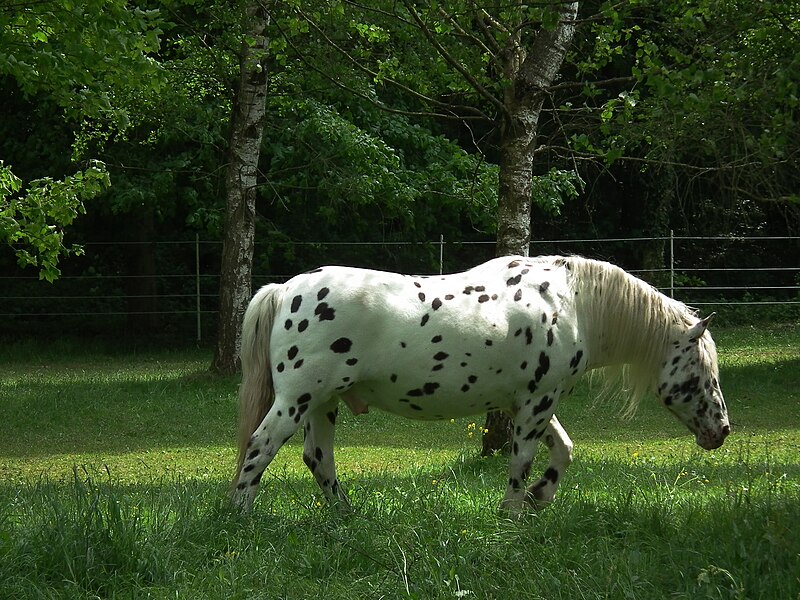

.JPG)



Nice post!!!!! What do you think about Retuerta horse that is claimed to be the most ancient breed in Europe?? Keep it up! Your blog is becoming a wealth for informations!!
ReplyDeleteThanks! Well, "ancient" is an ambiguous term. It either means that a breed is old (what does not necessarily imply it resembles its wild ancestor) or that it is "primitive". But for the Retuerta, I only know of a study from 2006 (can't recall the citation, sorry) that it has little influence from other Iberian breeds. That doesn't necessarily mean it is more primitive than other horses, and their phenotype doesn't resemble the wild horse that closely as well. That's why I didn't include it in this selection here.
DeleteGreat photos. I really want to learn more about horse breeding.
ReplyDeletehttp://www.horseshowcentral.com/horse_breeds/sorraia/327/1
ReplyDeletehttp://s1.zetaboards.com/anthroscape/topic/5051280/4/
http://www.spanish-mustang.org/SorraiaMustang/General.html
http://ravenseyrie.blogspot.com/
http://www.sorraia.org/
http://www.lhnet.org/sorraia-horse/
The Sorraia is not a particularly interesting breed to me. Only their coat resembles the wild horse (and only one colour morph), and everything else is lacking evidence, also concerning their breed history.
Deletehttps://en.wikipedia.org/wiki/Iberian_horse + Alter Real (?).
ReplyDeletehttp://www.aicsorraia.fc.ul.pt/ISAG2000.PDF
ReplyDeletehttp://www.uco.es/genetica/MERAGEM/archivos/ldgv/lab2.pdf
http://www.scielo.br/scielo.php?pid=S1415-47572002000200003&script=sci_arttext
http://www.aquilapre.com.au/Genetics/Genetic%20diversity%20and%20relationships%20of%20portuguese%20and%20other%20horses.pdf
http://bases.bireme.br/cgi-bin/wxislind.exe/iah/online/?IsisScript=iah/iah.xis&src=google&base=LILACS&lang=p&nextAction=lnk&exprSearch=335781&indexSearch=ID
http://www.equisport.pt/pt/
http://www.cavalo-lusitano.com/
http://www.aicsorraia.fc.ul.pt/criadores_portugal_modelo.htm
http://www.acerg.net/index.php?option=com_frontpage&Itemid=1
http://jackipicot.canalblog.com/archives/2012/03/07/23695910.html
http://www.cavalonet.com/pt/
http://www.cm-alpiarca.pt/concelho/locais-de-interesse/item/102-reserva-natural-do-cavalo-sorraia
http://www.flickr.com/photos/emoitas/2327904990/
http://karlshuker.blogspot.pt/2012/10/the-zebro-equine-mystery-from-iberia.html
http://publico.pt/ciencia/noticia/os-cavalos-do-sorraia-ainda-tem-um-sabor-selvagem-1441329
http://bicharada.net/animais/animais.php?aid=90
http://www.cienciahoje.pt/index.php?oid=48224&op=all
http://www.equisport.pt/pt/artigos/actualidade/um-cavalo-que-vem-do-passado
http://revistaaguavai.blogspot.pt/2013/07/sorraia-o-bisavo-do-lusitano.html
http://cavalosexoticos.blogspot.pt/2013/05/sorraia.html
http://www.dn.pt/inicio/ciencia/interior.aspx?content_id=1821950
http://www.petermaas.nl/extinct/speciesinfo/tarpan.htm
ReplyDeleteThank you for your comment. But: I don't know if all the "Anonymous" here are the same person, but I don't really appreciate comments that merely contain a link and no text at all, especially when it leads to websites repeating the same anecdotical stories that are repeated over and over. I am sorry.
DeleteTwo breeds of horses with unusual colors:
ReplyDeleteBritish Spotted Pony
Tiger Horse
The Tibetan Pony:
ReplyDeletehttp://en.wikipedia.org/wiki/Tibetan_pony
These two Tibetan breeds of horses also appear to be Tarpan-like:
Nangchen Horse
Riwoche Horse
Pachyornis have you read the paper of Michael Cieslak, 2011 on coat colour research in which he stresses the importance of finding the gene that causes "Dun" ?
ReplyDeleteIn regard of the sorraia (I can call myself a sorraia-fancier (I'm not the mr. anonymous here above though) but I like to bias between liking the sorraia as a "horseman" as a pretty elegant horse, and the fact that it is, or is not, going back straight to predomestic horses, and that more research could shed a different light on this strain of horse), so in regard of the sorraia I'd like to mention that biologists/ecologist/other-concerned-scientists for horses seem to accept only one conformation type (the stocky poney type) in contrast to what they accept for other species. Allthough there is the theory of Ebhardt on 4 ancient types, a more heavy built draft like type, a compact poneytype, a small refined arabian type and a larger refined steppetype. The first two are more located in colder, wetter, shaded ecotopes, the latter two are more located to hotter, drier opener ecotopes (based on volume/surface energyconsumption). So in that light you could see a horse like the sorraia as produce of different surrounding than were you situate the english and other ponies.
Cieslak points out two predomestic different populations, one on the eurasian steppe, the other on the iberian peninsula as glacial refuge (and probably a smaller third one in east-asia).
You compare the sorraia to the arabian based on it's slender type and on its convex head, while the typical head of an arabian is quite the opposite, really concave (allthough in the last decades it is really overemphasized and is becoming quite caricatural). I think the sorraia has more the type of head you find in iberians (lusitanos and pre, but mind the mix with arabians here), and of course they are related, but also the type of head you find in the Akhal Teke, a real desert/steppe horse in turkmenistan. I know arabians, lusitanos, pres, akhalteke are strictly domestication nominations, but should we reduce all physionomic differences to human selection ?
apart from that i have some thoughts on the colors pangare-bay of the exmoor and the grulla of konik/sorria/tarpan too. Pruvost, Cieslak et Al. searched for the allels E and e on the extension locus coding for black and non black, and for the allels A and a coding for bay and non bay. But there are 2 other allels at play on the agouti locus and that is A+(wildbay) and At (Sootybay), for the latter there is a genetic test now, but not yet for A+
If exmoors would be tested, they would rather rest for At Ii think, since that gene is causing a shading effect on bay horses from the top down, leaving ampits, belly, loins and mouth rather "mealy".
I think the gene for dun is rather to be found related to agouti than to other genes that code for dilutions of black in other species, while it was on those genes (fi. lavender in chickens) that Cieslak did his research but found nothing for dun there.
I would like to show some images but i think I better send those privately, is that possible ?
Hi, I plan to cover the Sorraia in a future post soon, I somehow never got to it. Ebhardt's hypothesis has no fossil support and therefore is rather baseless. I do not doubt at all that different environments do have an influence on the body conformation of horses, perhaps we can use living wild equine as an example. Nevertheless, there is no fossil evidence from the Holocene for a tall, slender predomestic horse that would resemble the Sorraia in conformation. I know Cieslak's paper and I am aware of the genetic separation of the Iberian wild horse population and the rest of the Equus ferus ferus subspecies, but that alone is no indication of a gross phenotypic change (many other large mammal species were isolated on Iberia too, including aurochs and wolves, for example). After all, Bergmann's rule (which is not as universal as it is often stated) would indicate that southern wild horses would have been actually smaller than northern ones.
ReplyDeleteYou can send me those images to daniel-foidl( )itmed-at ("-" is for ".", bracket for "@").
I don't know why nobody look at Iberian breeds, despite so many studies that talk about their genetic singularity: 1.Iberian population survived during the early holocene while the rest of Europe population practically desapears until neolitic. 2.Modern Iberian populations have one of the greatest genetic diversity of the World. 3.Iberian populations have some haplotypes that are not present in other populations or are very rare. And in front of this, the only thing that is said is that: 1. "Its apparience is not very similar as E.W. horse" (you only talk about the famous sorraias, but there are 12 native breeds in Iberia, and only 4-5 have suffered a strong selection by men). You should see an Asturcon, a Losino or a Galician horse. 2."Iberian horses are very influenced by foreign breeds"(This is only true for Lusitano and Andalusian horses. There are studies that show some Iberian breeds as some of the most purebred breeds in Europe. This wrong afirmation has no evidence in most of the Iberian breeds).
DeleteIf you want I can give you these studies. Is that a point of Central-eurocentrism or what? XD
If you want I can send you photos of all these breeds, including a real photograph of an Asturcon ;)
DeleteThe mtDNA patterns found in Sorraias can also be found in some other horse breeds. This is only natural, as our domestic horse breeds are usually a mix of populations, types, and breeds, a mixture of genotypes is therefore usually found in horse breeds, and the genotype of the Sorraia, or Tarpan, in horse breeds is thus easily explained.
ReplyDeleteThe mtDNA results are consistent with the presumed role of the Sorraia as one of the ancestors of those breeds. All 18 Sorraias sampled for this study had one of two mtDNA patterns (A1 and JSO41), both on the same branch in the phylogenetic network, and closely related to one of the two major mtDNA types found in Lusitanos and Andalusians (A3). The genotype found in Sorraias is completely unrelated to the other genotype found in Iberian horses (D1). This is remarkable regarding the status of the Sorraia.
That’s so great, amazing stuff of high quality; I appreciate you on your working. http://salisburyfarms.net/faqs/
ReplyDeleteThis article gives the light in which we can observe the reality. This is very nice one and gives indepth information. Thanks for this nice article. Horse Barn
ReplyDeleteThis comment has been removed by the author.
ReplyDeletei can't find anything on that Mülen pony ?
DeletePeter Donck ( Don'qui)
Sorry, DÜLMEN pony XD
DeleteThis comment has been removed by the author.
ReplyDeleteWhat do you think about Dülmen pony? It seems striking that nobody talks about him, despite the interesting story that he has (...and its morphology, its natural behabior...). of course I'm not trying to say that it may be the last European wild horse (e know everything is mixed with domestic horses).
ReplyDeleteThere is nothing unique about the Dülmen pony actualy, the modern population is nothing but a Konik crossbreed; maybe I'm going to do a post on that as well.
DeleteOf course, but I think they are just as interesting as koniks, exmoors, etc. I didn't know why you didn't mention them. If they are only konik-crossing, it's ok, I didn`t know that. I heard they came from native wild horses that were rescued by the Dukes of Croy in the mid-19th century.
DeleteThat's as much of a myth as those of the Sorraia, Konik and Exmoor (good point, I actualy should have included the Dülmen in my "wild horse myth" series). It is unlikely that the original population of the Dülmen horses were wild horses, and even if, the modern population is nothing but a mixed Konik as Konik stallions have been continuously used for breeding since the 1960s, and before that, other pony breeds have been used. That makes the Dülmen just an ordinary landrace, basically.
Deletethe question should not be "were the startup populations of konik, sorraia or exmoor really wild horses" but simply "how much of the original genetic makeup and thus fenotype is left unaltered and not ruined in those old strains of halfwild roaming horses". Set them out free again and they will be wild within a generation.... with all the behaviour necessary for survival ! Don'qui
DeleteAs numerous sources claim the direct ancestor populations of Konik, Sorraia and Exmoor were wild horses, I decided to do posts where the question is indeed whether these were wild horses or not. But your point is valid. Nevertheless, I haven't found really convincing arguments that those three breeds are unique among other landraces.
DeleteWithin one generation is neither plausible on genetic basis nor on behavioural basis; indeed it has been realized that horses remain quite domestic in their behaviour towards people even under wild circumstances (no flight distance or shyness) except for when they are hunted.
I have a sorraia stud, i have konik mares, i have lusitanos, appaloosas, i had arab, thoroughbred and mixed horses,my conclusion : yes sorraia and konik ARE different from the others.
ReplyDeleteWhen you set horses free and they suffered never any harm by man they will not flight, hunt them and they will. Same with all species, so what !!!! is that your definition of being "wild", that' a poor conclusion ! Don'qui / Peter Donck
In how far are they different?
DeleteNo I did not use that as definition for anything, I merely mentioned that while cattle re-develop shyness and flight distance quite fast under natural circumstances, it takes much longer in horses, which may be the case because horse domestication focused on behaviour much more than in cattle.
This comment has been removed by the author.
DeleteI think this is just a matter of what is the main point of interest. Why do we want to breed-back? What is "breeding-back"? I'm not trying to discredit this blog or any breeding-back project, I find all this very interesting, but I think romanticism is the biggest weight ratio for all this.
Delete-If the point is to bring back the real extinct wild subspecies, that is impossible except with cloning.
-If the point is to recover the old dynamics of ecosystems, generating an open forest landscape, I think that is impossible in a natural way only with horses, neo-aurochs and bisons. There were these species in the begining of the Holocene and all the tests say that it wasn't enough to keep the open spaces. Several studies suggest that the expanse of the forest was the main factor that made wild horses desappear from almost all of Europe during the Early Holocene, and the deforestation action of the human being allowed them to return during the Neolithic.
So why do we talk about whether it is more tarpan-like a konik or a sorraia? Why do we talk about the appearance of the auroch horns? Is it necessary for restoration of ecosystems? I think we only want to have a theme park (and that's perfect).
And regarding the question of behavior as an adaptation for survival, I think it is enough to use rustic breeds. I've been living in the Spanish field for 7 years, working with native cows and horses, and I saw herds of these cows and horses defending themselves from the wolves, while limousin cows were not able to save their calfs. A breed is not rustic due to its appearance, or even because of its lineage, but to the type of selection that has suffered for centuries.
It's my opinion.
your opinion is wrong, wild herbivores did keep the landscape open. the theory that they didnt is debunked 30 years ago. keep up old man
DeleteDaniël : i can agree with you on the difference between bos and equus, but with the last it all depends how they have been handled or treated.
ReplyDeleteAnyway, first of all they smell different :)
but they have a very inquisitive character, they have strong personalities, are very quick to learn new routines that are advantageous, they have an extremely well developed herdsense, all much more than othere horses, and i keep all my horses together as a herd, and they almost all have family ties, were born here and grew up under identical circumstances.
But what strikes me the most that sets them apart from other horses is their FUR, and i write fur because it is so different from what we see as normal horscoats. Their fur is much more in the thick and dense range of wild animals like hare, rabbits, wildboar, roedeer, fox.... Konik and sorraia are mostly described as 'grulla' being the black variant of DUN, but when you look up close you will clearly see they do have hues of yellow and red on their greyisch color, so i'am sure they do express both eumelanin and pheomelanin. Most research lately is focussing on DNA, comparing with ancient samples and mostly without knowing what sequences stand for. I think there is much to few microscopic research on hairdensity, partition of pigment in skin, hairfollicle and hairshafts.
Mario : it is not about appearance, fenotype but it's all about a genome that was fully adapted to wild life, that was responsible for behaviour, foodconversion, environmental adaptation, wheatherresistance and things like camouflage. So in the light of equus as species it is interesting to know what that genetic makeup was in predomestication times and what of it is left in modern horses, because most horses nowaday are really bulking with flaws and abnormalities, which people accept wihtout resistance or questionning but sight- and hearing problems, intestinal deviations, UVsensibility and more are known and documented through genetic research but nobody seems to care, the species only gets weaker and weaker.... Peter Donck
I was imprecise; what is supposed to set them apart from other *robust landraces*? I see nothing conclusive there. I never questioned that Konik and Sorraia can express both eumelanin and pheomelanin, in fact I often mentioned that black dun can exist in brownish shades several times on my blog. And I don't really know what that argument is about.
DeleteConsidering your paragraph directed to Mario: Indeed horses get ever more over-bred, like all domestic species. They are eroding genetically, and so do dogs and others.
If you don't see it, it does not mean it's not there !!! maybe you are blinded by your own "insights".
Deleteexpressing red and black pigment is essential, you see it in all wild mammals, even in birds. Pigment has it's functions, pigment is underestimated, f.i, there is a spanish paper on stressresistance in domestic pigs, result was that redhaired pigs (not expressing balck) were more nervous and more sensitive for stress.
Most domestic animals fail on pigmentexpression, they only express one of both or none, or show all kinds of white patches and spots ( impossibility to fill in wiht pigment starting from the neural crest), usually it starts in the extremities (feet, legs, usually starting left hind, point of tail) but also on the seam of the belly or the centerline of the face. It's all an erosion of the genome, of the segments responsable for color fill-in, and they are all linked to other physical anomalities of all sorts. In that optic it is primordial to go back to authentic colored animals. Peter Donck
Once again, what sets the Konik and Sorraia apart from other black dun landraces that express both red and black pigment? Of course I am aware of the biological function of pigments and I already mentioned that in several posts.
Deleteyou're allready narrowing down Daniel, to "black dun landraces".
ReplyDeleteI would say probably not much, they are valuable as well, i do not discriminate
Peter Donck
But that was already my point in the beginning: no special status for the Konik and Sorraia alone.
DeleteIt would be very interesting to know the complete genetics of the original wild horse (I will be very happy the day we know), but I don't think it is essential to obtain a horse landrace adapted to its original niche. The genetic proximity was not what allowed Iberian and Barb horses to survive and flourish in the American territories, nor their color:
ReplyDelete1.-The issue of color: Of course, there are certain colors that are disadvantageous for certain conditions, but I stress, FOR CERTAIN CONDITIONS. It's not an absolut rule, it depends of several factors. If you see mustang herds, you will see mostly black, bay and dun animals, but also grey, chesnut... And all perfectly adapted. There are many roan mustang too, a color very similar externally to the dun (but no, roan is not an original wild color!!). There are several studies that suggest that the grey color provides an advantage in the lacustrine habitats against mosquitoes (similar to the black and white color in zebras), and this is in accordance with the majority color in lacustrine feral and semi-feral populations like Camargue, Criollo Llanero and Pantaneiro horses. We know that Leopard Complex carries a genetic defect related to a type of blindness (in homozygosis), and despite this we now know that some Ice Age horses also had a leopard color. The individuals with the Leopard gene in homozygosis did't last long, but the characteristics of that coat made it advantageous (in some way) and that is why that gene did not disappear.
2.-The issue of survival capacity, instinct, behabior... of modern breeds: I am not considering modern breeds at any time. Of course they have suffered a very strong selection that has deformed their characteristics and reduced their adaptive capacities. But I do not know if you are aware of the large number of "landraces" (in Spain we say "environmental types") of horses that have been living in the wild for hundreds of years until now. These populations have suffered and suffer the same conditions suffered by wild horses: The weather throughout the year, search for food without help and defense against attack by predators. Of course, the human being has modified some characteristics, but only those that were compatible with survival in the wild.
As long as we don't get to "clone" the wild horse, I believe that any "robust landrace" (Exmoor, Konik, Fjord, Iberian ponies...) is good to play its role. From an ecological point of view, I do not see the need to cross them with each other. The only interest I see there is aesthetic (and it doesn't seem bad to me, by the way).
Some Portuguese Equine Breeds:
ReplyDeletehttp://www.sprega.com.pt/conteudo.php?idesp=equinos
Great blog, your contents are great . Ever since i found your blog I have been reading every single article. Really love the way you took out your time to explain Horse Breeds . Thank you , you are doing a great job .
ReplyDeleteMy understanding is that the genetic diversity of Mongolians, as well as what we know of their history indicates a likelihood that they are a basal breed for all or most of the domestic breeds that followed. That suggests to me that a rewilding project should be based on Mongolians, perhaps selected for the most tarpan-like characteristics. Just designate a sanctuary, let a bunch of them go, and let nature take its course.
ReplyDeleteThe diversity of ancient breeds also suggests to me that they are a living record, almost like a box of forensic puzzle pieces, of the history and heritage of horse domestication. They also preserve the genetic legacy of the tarpan. Perhaps conserving these breeds should be a priority, and and rewilding could serve in that effort. Herds of different breeds could be maintained at their own sanctuaries where they could fill the ecological roles of tarpans while maintaining their own genetic vitality. I would say the same for ancient cattle breeds. I believe the Exmoor ponies are an example of this treatment.
I am still forming my thoughts about this but I have an affinity with landraces and a distrust of intervention through intensive breeding.
Portuguese breeds of horses:
ReplyDeletehttps://www.sprega.com.pt/
https://www.sprega.com.pt/conteudo.php?idesp=equinos
Spanish breeds of horses:
https://feagas.com/
https://feagas.com/razas/equino-caballar/
Italian breeds of horses:
https://www.agraria.org/
https://www.agraria.org/equini.htm
http://eng.agraria.org/
http://eng.agraria.org/horse.htm
http://esp.agraria.org/
http://esp.agraria.org/caballos.htm
French breeds of horses:
https://www.racesdefrance.fr/
https://www.racesdefrance.fr/chevaux
https://www.racesdefrance.fr/chevaux/races-de-trait
Some Portuguese Horse Breeds:
ReplyDeletehttp://www.acerg.net/
http://www.acerg.net/index.php?option=com_frontpage&Itemid=1
http://www.cavalo-lusitano.com/
http://www.aicsorraia.com/
http://www.aicsorraia.com/index.html
http://www.aicsorraia.fc.ul.pt/ISAG2000.PDF
http://www.aicsorraia.fc.ul.pt/criadores_portugal_modelo.htm
https://www.facebook.com/APSL.Cavalo.Lusitano/
Deletehttps://www.acerg.pt/
Deletehttps://www.garranos.pt/
http://garrano.ipvc.pt/
https://alterreal.pt/
Deletehttp://www.alterreal.pt/
https://www.facebook.com/AlterReal/
http://www.garranos.pt/
Deletehttps://www.facebook.com/Associa%C3%A7%C3%A3o-O-Caminho-do-Garrano-1940938019524183/
The Yakutian Horse:
ReplyDeletehttps://pleistocenepark.ru/animals/horses/
The Polesskaya Horse:
ReplyDeletehttps://rewildingeurope.com/news/european-rewilding-network-welcomes-belarusian-horse-rewilding-initiative/
https://rewildingeurope.com/rew-project/reintroducing-the-polesskaya-horse/
https://rewildingeurope.com/european-rewilding-network/
Needed to post you that bit of note to be able to give thanks over again about the awesome concepts you’ve documented in this case. The post you shared is very unique and informative.
ReplyDeletePrecision Nutrition
Can the Wild Horse return to Portugal?:
ReplyDeletehttps://www.wilder.pt/naturalistas/pode-o-cavalo-selvagem-voltar-a-portugal/
The more important question is: can you stop posting those links on my blog all the time? Because that's rather annoying since you post them every day and I don't appreciate that.
Delete